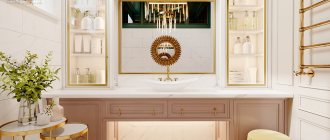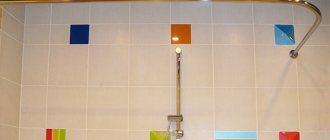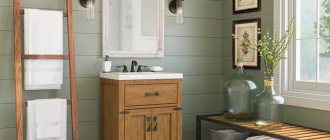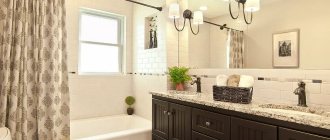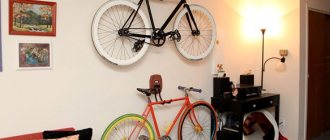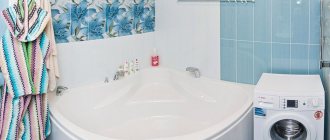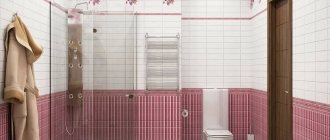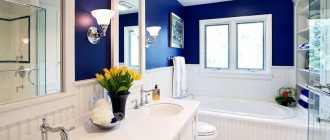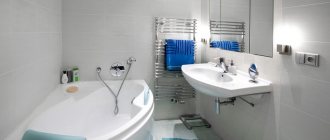Click to share
Bathroom wall cabinets are currently one of the most commonly purchased furniture solutions. While they require a rethink of hanging location and precise assembly, their style and functionality are a huge benefit.
Find out from us at what height to install wall-mounted bathroom cabinets so that they can be used safely and comfortably.
Hanging bathroom furniture is not only aesthetically pleasing, but also very practical. This is especially good for small bathrooms where every centimeter matters. Unfortunately, compared to regular furniture, installation of wall-hung models is longer, more labor-intensive, and requires precise measurements of the space - not only for installation, but also for you to enjoy using it. At what height should you install wall-hung cabinets in your bathroom to make them comfortable to use?
Hanging cabinets for the bathroom - let's start with size
Before you think about how to install wall-hung cabinets in your bathroom, consider choosing the right model. To do this, it is worth considering the amount of storage space required and the size of the bathroom.
Shops include under-sink bathroom cabinets, tall columns, large hanging cabinets, and wide or narrow chests of drawers. You must remember that you should not overload such cabinets, so try to choose models both for the capabilities of our bathroom and the number of things you want to store.
What depth of hanging cabinets should I choose?
A very important parameter determining the purchase of hanging cabinets is their depth. We differentiate cabinets with depths of 15, 20, 25 and 30 centimeters.
The first of them are most often used in small bathrooms. They don't have much capacity, so they won't be suitable if you want to store larger items or cleaning supplies in them.
Hanging cabinets with a capacity of 20 cm are definitely a better solution than 15 cm models. They are suitable for cosmetics and cleaning products. Manufacturers offer many 20-centimeter models with different textures and colors. If you choose the sliding door option, it can also be used in bathrooms with a small space.
Cabinets that are 25cm deep can also fit, but careful consideration must be given to purchasing and assembly. While corner models this deep won't be a problem either (provided you have enough space in the bathroom), a cabinet over a sink this deep can be a big problem, limiting space in the laundry area.
Cabinets with the greatest depth - 30 cm - are definitely not recommended to be installed directly above medium or small sinks. This choice will definitely become an obstacle in your daily routine in the bathroom.
Primary requirements
The main parameter that you need to focus on when choosing is the dimensions of the room. If in small rooms they usually make do with one option - a mirror above the washbasin, then in spacious rooms there is more space for spectacular design solutions. Usually several products are placed here.
At the same time you need to take into account:
- Reflective surface area. The size of the canvas should not be too small, otherwise it will be inconvenient to use. It is best to focus on the dimensions of the cabinet with washbasin - rectangular and square mirrors should be slightly smaller than its width. It’s easier with round, oval, asymmetrical models - there are no strict requirements for them, so the size is selected to your liking. The main thing is to maintain proportions so that the bathroom decor looks harmonious.
- Height from the floor. The accepted standard is 1.2–2 m. Usually the position of the upper edge of the canvas is determined individually - 10–20 cm is added to the height of the tallest family member. However, if necessary, the height of a mirror installed above the sink in the bathroom can reach the ceiling, if that requires design thought.
- Distance from the washbasin. Typically 20–30 cm to minimize droplets. If the mirror is equipped with an open shelf, then a smaller gap is allowed - from 5 to 10 cm.
In addition, when choosing the height of the bathroom mirror from the sink, you need to take into account the height of the smallest family members. If the reflection is too high, they won't be able to see themselves. The height of the mixers is also decisive.
At what height should I install a hanging cabinet for a bathroom and how to do it?
Before you begin installing your bathroom cabinets, let's refer to the manufacturer's instructions. Even if it seems to you that you are perfect “craftsmen”, you may miss something. Reading the instructions will help you avoid such mistakes. Before starting assembly, make sure we have all the necessary tools and materials, especially fasteners, which are not always included with cabinets.
Installing a wall-mounted vanity cabinet (and more) starts with unpacking all the elements. Then you measure the height at which you want the cabinet to hang. The cabinet together with the sink should be between 80 and 90 cm high, it is best to take the average measure, that is, 85 cm.
The next step, which requires precision, is drilling the holes to install the cabinet mounting strips. You install them using plugs and then hang the cabinet on them.
Expert advice . Before assembling the hanging cabinet, make sure what the walls you want to attach it to are made of. This will depend on which connector you choose. If cabinets are to be hung on hollow or perforated bricks, you will need special dowels or anchors for use in hollow core materials.
When the cabinet is hanging on the mounting strip, check its strength and levelness. If the cabinet does not hang level, it will affect the proper functioning of the cabinet. The complete installation is completed by placing the sink on the wall cabinet. Next, use silicone where the wall mounted sink cabinet meets the wall.
Marking rules and installation technology
Determining the height is half the process. The height of the mirror above the sink should be optimal for all family members. Next, you need to mark the wall taking into account the location of the fasteners.
Standard lighting creates maximum comfort
Installation on fasteners
The sequence of work is represented by the following algorithm:
- Using a level, place the upper corner and central edge location marks on the wall.
- Since the premises throw surprises at the owners in the form of uneven walls and floors, it is worth placing a piece of paper in this place in size (a piece of old wallpaper will do) and check by eye the horizontal and vertical positions relative to the other elements.
- Measure the distance in the corners from the attachment point to the edge. Place marks and then drill holes for dowels or brackets. Since mirrors are made of heavy material, this should be taken into account during installation. Store consultants can help you select consumables that meet your load requirements.
Standard bathroom
To hang a mirror on fastening elements, spacers made of soft polypropylene moisture-resistant material are attached between the wall and the canvas. This is necessary to relieve pressure from the wall and fixing devices. When installing, the brackets are not fully tightened and leave a small gap.
Asymmetrical surface at height
Installation using construction adhesive or mounting tape
The order of these works is outlined below step by step:
- When using these types of fastening, just as in the first case, marks are placed along the entire perimeter. The area under the mirror is thoroughly cleaned of unnecessary elements by drilling and carefully removing the tiles.
- When drilling, paper tape is placed under the drill on the surface. This little trick helps maintain the integrity of the edges and avoid chipping. It is advisable that there is a gap of 2–5 mm at the edges from the canvas to the tiles on the wall for ease of installation. After the wall is cleared of all excess on the surface, it is cleaned to a smooth state. Unevenness will cause the mirror to stick unevenly. This situation is fraught with consequences in the form of moisture accumulation and fungus formation.
- The reverse side is coated with construction glue or liquid nails. Apply mounting tape. Care must be taken to ensure that there are no gaps left. Install the mirror with support on the bottom edge. Then gently press it against the wall. For more reliable fixation, it is recommended to hold it for 15–20 minutes. You can use fasteners for fastening, which are removed after the glue dries.
In a gilded frame
Calculation of the position and cleaning of the wall is done when the mirror has already been purchased. Otherwise, you may encounter discrepancies in calculations and, as a result, additional work.
Wall cabinet with mirror
It is also worth mentioning the hanging wardrobe with a mirror. This is a very functional solution that is suitable for any bathroom.
There are many types of mirrored cabinets in the market. You can choose from two or three door models. In addition, if you want lighting in the wash area, then purchase a hanging cabinet with a mirror equipped with LED lighting.
The question remains - at what height should this type of cabinet hang? To comfortably enjoy the delights of the mirror, our eyes should be at a height of 3/4 from the bottom edge of the glass. It is this parameter that we should be guided by when installing a mirror cabinet above the sink.
No. 2. Mirror wall cabinet
Mirror cabinets are found among vertical, corner and horizontal options. The convenience of such pieces of furniture is obvious, because the cabinet allows you to completely replace the mirror, which is a mandatory attribute of the bathroom. It turns out that when buying a model with mirrored doors, you can save not only space, because you won’t need a separate mirror, but also money.
Bathroom cabinet - what else is important to know?
Bathroom cabinets should be functional. The door should close and open slightly, have strong hinges and a comfortable handle, the same applies to drawers. If the bathroom has many compartments and shelves, each member of the family will probably put their toiletries in it and find them easily.
Check if your bathroom shelves are too narrow or too small. The distance between shelves should be adjusted to the size of toiletries and cosmetics.
The bathroom, like no other room in the house, is subject to frequent changes in humidity and air temperature, so hanging cabinets must have a special finish. It is very important that both their bodies and facades are made of furniture boards with increased moisture resistance. The type of finish on the front door elements and drawer fronts is also particularly important. This can be a special veneer, protected with two-component waterproof polyurethane varnishes.
The correct manufacturing technology for these coatings is no less important. When purchasing, make sure the cabinet is properly finished. It is unlikely that you will check this yourself, so ask the seller. He must know the product he is selling, although he is not obliged (the manufacturer is not obliged to include a technical description of the furniture).
Wall cabinet for the bathroom - which one is best?
- Wooden hanging cabinets look beautiful and are not expensive. They should be coated with waterproof varnish and made of coniferous wood so that they are not damaged by moisture and heat.
- MDF cabinets are less durable than wood, so they must be covered with at least three layers of protective material.
- Cabinets made of chipboard and fiberboard - the facade is usually covered with laminate or veneer. Natural veneer must be painted with waterproof varnish.
- Plastic cabinets - Plastic cabinets are cheap, but not very durable: if impacted, they easily break and become perforated. They are resistant to heat and moisture and are also easy to clean.
- Metal cabinets - metal cabinets are resistant to mechanical damage. Metal elements must be made of stainless steel, painted with waterproof varnish or coated with a protective coating: nickel-chrome, tin, zinc or aluminum.
- Glass Cabinets – Glass bathroom cabinets usually only have certain elements, such as shelves or doors. You can also buy furniture made from clear or milky glass, but they are very expensive. It should be remembered that the contents of such a cabinet will be visible.
Fastening methods and necessary tools
A mirror is a fragile item that breaks easily, so its installation must be reliable and durable. You can fix the product in different ways. What tools are required for this depends on the type of work.
Design and types of mirrors, how to make a product with your own hands
Dowels and self-tapping screws are one of the most reliable fastenings; they can withstand the weight of a heavy object well. The dowels are installed in the drilled holes in the wall, then self-tapping screws are driven into them. The number of elements depends on the area of the product: the larger it is, the smaller the gaps between them should be. The recommended drilling depth is 5–7 cm. The mirror is hung at a short distance from the wall to ensure natural ventilation.
Bolts and screws are also a popular option. It is best to purchase mirrors with prepared holes. If they are not there, drill them yourself with a diamond drill, and then sand the sharp edges. The product is attached to the wall in prepared holes, the bolt heads are covered with decorative caps.
Plates are a good option for hidden fastening of canvases without frames. Steel parts are durable, resistant to mechanical stress, and can withstand heavy loads. Before hanging the product, the plates must be glued to its back. Next, drill holes in the wall and install self-tapping screws in them that will hold the plates with the mirror.
Glue, sealant - an option for “eternal” fastening, suitable for canvases weighing from 10 to 20 kg. Advantages – no need to drill holes. Procedure: level the wall to perfect condition (as before painting), install temporary supports for the mirror, degrease the wall. Apply adhesive to the back of the canvas. Having placed the piece of furniture on the supports, press it against the wall and secure it tightly. Remove the auxiliary elements after a few days. Proceed in the same way when gluing a mirror to sealant or liquid nails.
Double-sided tape - this method is suitable for small products without a frame. When choosing this method, you should pay attention to the moisture resistance of the adhesive tape, since this determines how long the mirror will hang. To attach it, the tape is cut into small pieces and glued to the fat-free back side. Having removed the protective layer from the tape, apply the mirror to the markings on the wall and fix it with your hands for better adhesion to the surface.
Functionality of a mirror with lighting for makeup, types of products
Dowels and screws
Bolts, screws
Plates
Glue, sealant
Double sided tape
Where to buy hanging bathroom cabinets?
The best place to find bathroom furniture is where plumbing fixtures are available—in bathrooms, at a home improvement center, or at a specialty plumbing store. You can count on professional service. Additionally, by actually looking at hanging cabinets in their natural surroundings, it will be easier to choose a piece of furniture or mirror that suits your bathroom.
Hanging cabinets can also be made to order. If the bathroom is small, you should use mirrors that will visually increase its space. In addition, the standard should be sufficient for us, that is, a shelf under the mirrors or perhaps bathroom cabinets under the sink. However, where possible, it is worth having cabinets for towels, cleaning products, toiletries, and underwear.
As we already mentioned, a wall-hung cabinet is ideal for a modern bathroom. This is an elegant solution for small interiors - the free space between the bottom of the cabinet and the floor will provide an optical increase in space, and will also allow you to stand as close as possible to the sink. The aforementioned space between the bottom of the cabinet and the floor is both a plus and a minus - on the one hand, it allows easy access to dusty niches, on the other, it requires more frequent and thorough cleaning.
Mirror installation process
Bathroom tiles: how to choose 42 photos suitable
The installation procedure for the product depends on the selected installation method.
Glue mount
The advantage of this method is that there is no need to use fasteners that may be visible on the front of the mirror.
Special liquid nails or adhesive-sealant are used as fasteners. You need to choose only those compounds that are suitable specifically for fastening mirrors.
Any unsuitable glue will damage the surface of the mirror or not provide a reliable result.
Before gluing, it is necessary to apply putty and primer to the wall surface. It is prohibited to mount the mirror on top of acrylic paint and plaster, as they have a negative effect on the moisture-resistant coating. If installation is planned to be carried out over tiles, then it must be thoroughly cleaned and degreased.
The glue should be applied to the back surface of the mirror, after which the product is pressed against the wall for 10-15 minutes until the glue has completely hardened.
Screw mounting
This fastening method is chosen when the product weighs significantly. Screws can be included with the mirror or purchased separately. The number of screws is calculated based on the size and weight of the mirror.
In addition to the screw and dowel, rubber gaskets must be available. Also, to achieve greater aesthetics, you should use special decorative plugs that best suit the style of the bathroom.
If the mirror is sold with ready-made holes for fastening, then all that remains is to attach it to the wall with screws. The absence of such holes greatly complicates the task.
You can drill them using a diamond drill of the required diameter. While drilling, it is necessary to constantly cool the surface of the mirror so that it does not crack. The resulting holes should be sanded.
Be sure to use rubber gaskets on the back side between the wall and the mirror, as well as between the mirror and the plug on the front side of the product.
Installation with double-sided tape
This mounting method is the simplest, but is only suitable for light weight mirrors. The tape itself must be moisture resistant.
The adhesive tape must be cut into strips of the required length and attached with one of the sides freed from the protective film to the back surface of the mirror. Then the protection is also removed from the second side of the tape, after which the product is tightly applied to the wall.
If the mirror is mounted in a special recess without tiles, then all joints between the product and the tile must be treated with silicone sealant.
It is important to understand that installing a mirror is a fairly complex technical procedure, which can result in damage to the product. If you do not have the necessary skills and tools, you should entrust the installation of the mirror to professionals
Thus, the non-standard placement of the mirror above the bathtub has its advantages and disadvantages. The size of the mirror, its location and design must fully correspond to the parameters and style of the bathroom in which it will be installed.
The mirror can be mounted using glue, fasteners, or double-sided tape
During the installation process, it is important to exercise extreme caution so as not to damage the product.
Advantages and disadvantages
The placement of the mirror above the bathroom has its strengths and weaknesses. The advantages of such an installation include:
- Effective use of the free wall above the bathtub. This allows you to save wall space in living rooms and use them from a more practical side (installation of shelves, wall cabinets, racks, etc.).
- Visual increase in space. Using a large mirror above the bathtub in small rooms allows you to expand the space. It looks especially advantageous to have two mirrors - above the sink and above the bathtub.
- Several location options. The large area of the wall above the bath allows you to experiment with the placement of the mirror. It can be located horizontally, vertically, or at an angle.
- All family members have the opportunity to see themselves in full growth. The standard placement of a mirror above the washbasin usually allows a tall person to see himself up to the waist, and a short person to see himself up to the shoulders. The mirror above the bathroom can have such a location and size that it will reflect the full height of any family member.
- Additional conveniences during hygiene procedures. The ability to shave, apply masks, and perform other manipulations in front of a mirror directly while taking a shower or bath is a big plus.
- An abundance of shapes and design solutions. The absence of size restrictions allows designers of such mirrors to experiment to the maximum. The mirror can have a traditional shape (square, round, oval, rectangular), or it can be more original (wavy edges, irregular shapes, silhouettes of animals or plants, etc.).
- A large mirror allows you to hide the imperfections of the wall panel.
Despite the large number of positive aspects, it is important to pay attention to the disadvantages of this arrangement of equipment:
- The need to frequently wipe the mirror, since constant contact with water will lead to streaks and drip marks.
- Installing a large mirror close to the top edge of the bath makes it impossible to seal the joints. The lack of overlap at the joints leads to water penetration under the bathtub and the appearance of dampness.
- The possibility of using a mirror directly during water procedures appears only with the installation of a special heating system, which significantly increases the cost of the product and the work on its installation.
- Most people prefer to use a mirror above the vanity and may have difficulty positioning the element above the bathtub.
Facades - views and decor
Facades may differ in:
- Open. The valves are completely absent. Everything you put inside will be visible;
- Closed. The cabinet system includes movable doors behind which the contents can be hidden;
- Combined. Some of the shelves will remain visible. The rest of the space will be covered with doors.
The best way to make your cabinet unique is to choose the right decor:
- Fusing. Colored pieces of glass are placed into an ornament and sintered at high temperatures into a single layer. This is a kind of glass “casserole”. Next, all this is transferred to a thick self-adhesive film. The fusing technique will not only create a unique design for the facade, but will also provide good protection for it. Just stick it yourself;
- Mosaic. For it, it is better to select materials with good resistance to water. These can be pieces of mirrors, colored glass, or natural stone veneer. Requires meticulousness and patience in production. But the final appearance is beyond praise;
<
>
- Eco leather. This is one of the synthetic varieties with a complete imitation of the texture and pattern of natural leather. Soft, greatly facilitates the process of tightening. Very pleasant to the touch. The pronounced pattern with deep grooves can accumulate dust. But, at the same time, the material tolerates washing well;
- Decorative glass. If you don’t like the fact that the glass does not hide the inside of the cabinet, then use lakobel (the inside is painted). Milk glass would be a good option. It is etched with acids while maintaining gloss. But matted will be rough. Laser engraving allows you to apply a detailed pattern of any depth (volume). In the end, the glass can simply be tinted. All of these methods partially or completely deprive glass of the ability to transmit light. This means visibility will be almost zero.
Preliminary preparation for installing a new mirror in the bathroom
Before fixing the canvas to the wall, treat the required area with a waterproof chemical and a special anti-fungal liquid. This is a necessary measure that will prevent the negative effects of moisture on the fastening and the appearance of harmful microbes behind the mirror.
Pay very close attention to the front surface of the reflective sheet. It can be damaged very easily and unnoticeably. If there are substances such as lye, acrylic or sulfur left in your bathroom after a renovation, remove them immediately. Even the slightest contact with acrylic paint, putty or plaster can damage the mirror surface.
To properly install the mirror, prepare the following tools: level, tape measure or ruler. It is these tools that will help you choose the optimal angle, level and distance between the sink and the mirror.
A level is a necessary tool for high-quality mirror installation.
If you do not check the position of the mirror with a level, you can expect, at a minimum, an unstable position of things that will stand on the shelves, and, at a maximum, an uneven load on the fasteners, as a result of which one of them may not withstand and then your bathroom will again be left without a reflective sheet.
How to hang a cabinet on the wall step by step instructions
Which grout to choose for treating the surface of tiles in the bathroom
Wall cabinets come in three types:
- horizontal;
- vertical;
- corner.
There is no fundamental difference in the technology of attaching them to the wall. To work you will need a set of tools and accessories:
- roulette;
- construction level (spirit level);
- marker;
- hammer drill with drills with a diameter of 8-10 mm;
- hammer;
- pliers;
- shaped screwdriver.
As a rule, the cabinet is already equipped with hinges for hanging, but anchor bolts, plastic fillers and hooks for hanging should be purchased.
If the wall in the bathroom is made of concrete or solid brick, the following should be done to hang the cabinet.
Using a tape measure, mark the desired upper level of cabinet mounting. A marker is placed on the wall corresponding to the location of one of the loops. The distance between the centers of the eyelets of the hinges is measured and set aside from the first mark
It is important that both holes are at the same level, which is controlled by the spirit level. Using a hammer drill, holes are drilled to a depth corresponding to the length of the plastic filler. In the event that it is necessary to drill ceramic tiles, the impact mode should be turned off by moving the hammer drill lever to the simple drilling position
Once the tiles have been drilled, the hammer drill's hammer mode can be used again. Plastic fillers are hammered into the resulting holes with a hammer. The hooks are screwed in, for which you should use pliers in the final stage.
The cabinet is hanging.
To hang cabinets on walls made of fragile materials (for example, made of gypsum blocks), hooks with plastic fillers should be replaced with anchor bolts. Heavy cabinets require fastening not only at the top, but also at the bottom. For this purpose, special support brackets are used.
Recently, special fastening strips and special devices (canopies) are used to hang cabinets in a hidden way. This method is especially convenient if you need to hang several cabinets on the wall at the same level. To do this, first fix a common fastening strip of the required length in level. After this, fasteners (canopies) are installed on the cabinet bodies and then the furniture is hung.
In conclusion, here is a video that reveals some of the nuances that arise in the process of hanging a cabinet.
Selecting a mirror
When choosing a mirror, it is important to pay attention to its susceptibility to moisture. For the bathroom, the best equipment is the one on the back of which is applied a special composition with aluminum or silver.
For the bathroom, the best equipment is the one on the back of which is applied a special composition with aluminum or silver.
The presence of a moisture-resistant coating is indicated by the blue or green color of the reverse side of the mirror.
A purple tint on the back wall means the mirror is unsuitable for the bathroom.
The coating, which includes silver, is of the highest quality. Currently, products made from silver amalgam with several layers of special varnish that perform a protective function are popular. But their cost is much higher.
Also, when choosing a mirror, it is important to pay attention to the following points:
Product size. The larger the mirror, the better. It is advisable to choose the maximum allowable mirror size in terms of room parameters. If there is a significant difference in height between family members, you should choose a product with a vertical shape.
Smoothness of the reverse side. The presence of roughness, scratches or defects indicates poor quality.
Weight. The more a mirror weighs, the longer it will last.
Reflection quality
It is important to ensure that objects are clearly displayed across the entire surface of the mirror.
Reliability of fastening elements. Poor fasteners will significantly complicate the installation of the product.
Frame material
The mirror can be framed. Preference should be given to materials that resist corrosion and deformation under the influence of moisture (steel, plastic).
Mirror and frame style. The product must fit into the overall design of the room.
An excellent option is to replicate the shape of the room and the bathtub itself above which it will be mounted.
For a high-tech room, a mirror of a regular geometric shape without a frame is suitable, while in a classic bathroom a product with an ornate frame will look harmonious.
